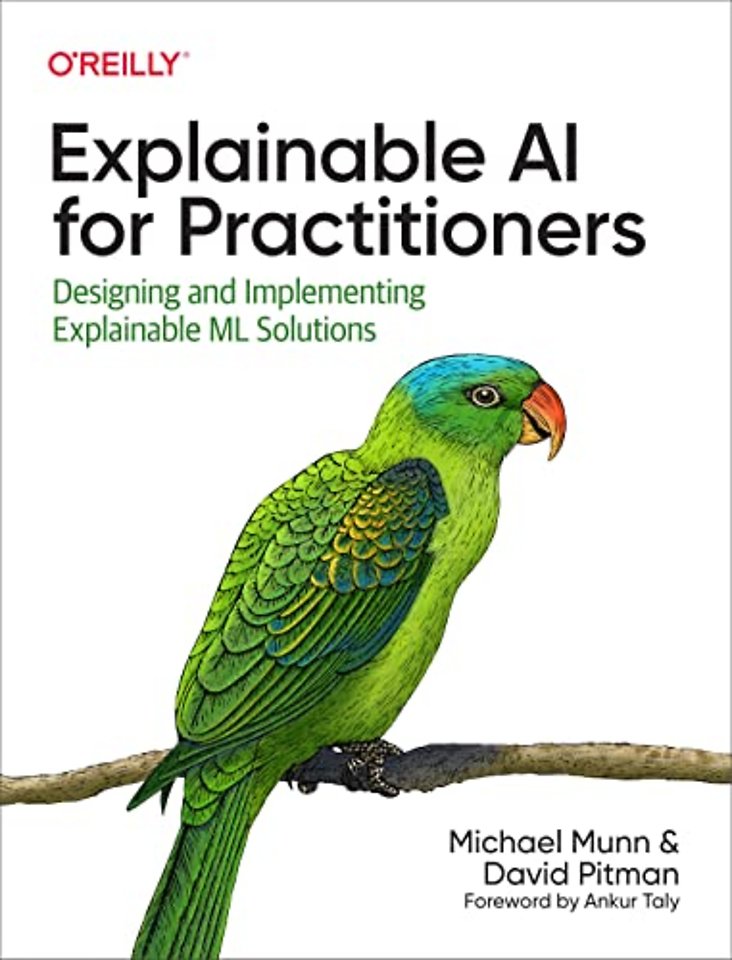Explainable AI for Practioners
Designing and Implementing Explainable ML Solutions
Paperback Engels 2022 1e druk 9781098119133Samenvatting
Most intermediate-level machine learning books focus on how to optimize models by increasing accuracy or decreasing prediction error. But this approach often overlooks the importance of understanding why and how your ML model makes the predictions that it does.
Explainability methods provide an essential toolkit for better understanding model behavior, and this practical guide brings together best-in-class techniques for model explainability. Experienced machine learning engineers and data scientists will learn hands-on how these techniques work so that you'll be able to apply these tools more easily in your daily workflow.
This essential book provides:
- A detailed look at some of the most useful and commonly used explainability techniques, highlighting pros and cons to help you choose the best tool for your needs
- Tips and best practices for implementing these techniques
- A guide to interacting with explainability and how to avoid common pitfalls
- The knowledge you need to incorporate explainability in your ML workflow to help build more robust ML systems
- Advice about explainable AI techniques, including how to apply techniques to models that consume tabular, image, or text data
- Example implementation code in Python using well-known explainability libraries for models built in Keras and TensorFlow 2.0, PyTorch, and HuggingFace
Specificaties
Lezersrecensies
Inhoudsopgave
Preface
Who Should Read This Book?
What Is and What Is Not in This Book?
Code Samples
Navigating This Book
Conventions Used in This Book
O'Reilly Online Learning
How to Contact Us
Acknowledgments
1. Introduction
Why Explainable AI
What Is Explainable AI?
Who Needs Explainability?
Challenges in Explainability
Evaluating Explainability
How Has Explainability Been Used?
How LinkedIn Uses Explainable AI
PwC Uses Explainable AI for Auto Insurance Claims
Accenture Labs Explains Loan Decisions
DARPA Uses Explainable AI to Build 'Third-Wave AI'
Summary
2. An Overview of Explainability
What Are Explanations?
Interpretability and Explainability
Explainability Consumers
Practitioners' Data Scientists and ML Engineers
Observers' Business Stakeholders and Regulators
End Users' Domain Experts and Affected Users
Types of Explanations
Premodeling Explainability
Intrinsic Versus Post Hoc Explainability
Local, Cohort, and Global Explanations
Attributions, Counterfactual, and Example-Based Explanations
Themes Throughout Explainability
Feature Attributions
Surrogate Models
Activation
Putting It All Together
Summary
3. Explainability for Tabular Data
Permutation Feature Importance
Permutation Feature Importance from Scratch
Permutation Feature Importance in scikit-learn
Shapley Values
SHAP (SHapley Additive exPlanations)
Visualizing Local Feature Attributions
Visualizing Global Feature Attributions
Interpreting Feature Attributions from Shapley Values
Managed Shapley Values
Explaining Tree-Based Models
From Decision Trees to Tree Ensembles
SHAP's TreeExplainer
Partial Dependence Plots and Related Plots
Partial Dependence Plots (PDPs)
Individual Conditional Expectation Plots (ICEs)
Accumulated Local Effects (ALE)
Summary
4. Explainability for Image Data
Integrated Gradients (IG)
Choosing a Baseline
Accumulating Gradients
Improvements on Integrated Gradients
XRAI
How XRAI Works
Implementing XRAI
Grad-CAM
How Grad-CAM Works
Implementing Grad-CAM
Improving Grad-CAM
LIME
How LIME Works
Implementing LIME
Guided Backpropagation and Guided Grad-CAM
Guided Backprop and DeConvNets
Guided Grad-CAM
Summary
5. Explainability for Text Data
Overview of Building Models with Text
Tokenization
Word Embeddings and Pretrained Embeddings
LIME
How LIME Works with Text
Gradient x Input
Intuition from Linear Models
From Linear to Nonlinear and Text Models
Grad L2-norm
Layer Integrated Gradients
A Variation on Integrated Gradients
Layer-Wise Relevance Propagation (LRP)
How LRP Works
Deriving Explanations from Attention
Which Method to Use?
Language Interpretability Tool
Summary
6. Advanced and Emerging Topics
Alternative Explainability Techniques
Alternate Input Attribution
Explainability by Design
Other Modalities
Time-Series Data
Multimodal Data
Evaluation of Explainability Techniques
A Theoretical Approach
Empirical Approaches
Summary
7. Interacting with Explainable AI
Who Uses Explainability?
How to Effectively Present Explanations
Clarify What, How, and Why the ML Performed the Way It Did
Accurately Represent the Explanations
Build on the ML Consumerâs Existing Understanding
Common Pitfalls in Using Explainability
Assuming Causality
Overfitting Intent to a Model
Overreaching for Additional Explanations
Summary
8. Putting It All Together
Building with Explainability in Mind
The ML Life Cycle
AI Regulations and Explainability
What to Look Forward To in Explainable AI
Natural and Semantic Explanations
Interrogative Explanations
Targeted Explanations
Summary
A. Taxonomy, Techniques, and Further Reading
ML Consumers
Taxonomy of Explainability
XAI Techniques
Tabular Models
Image Models
Text Models
Advanced and Emerging Techniques
Interacting with Explainability
Putting It All Together
Further Reading
Explainable AI
Interacting with Explainability
Technical Accuracy of XAI techniques
Brittleness of XAI techniques
XAI for DNNs
Index
About the Authors
Anderen die dit boek kochten, kochten ook
Rubrieken
- advisering
- algemeen management
- coaching en trainen
- communicatie en media
- economie
- financieel management
- inkoop en logistiek
- internet en social media
- it-management / ict
- juridisch
- leiderschap
- marketing
- mens en maatschappij
- non-profit
- ondernemen
- organisatiekunde
- personal finance
- personeelsmanagement
- persoonlijke effectiviteit
- projectmanagement
- psychologie
- reclame en verkoop
- strategisch management
- verandermanagement
- werk en loopbaan







